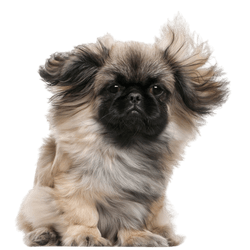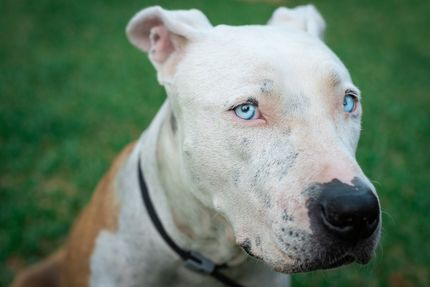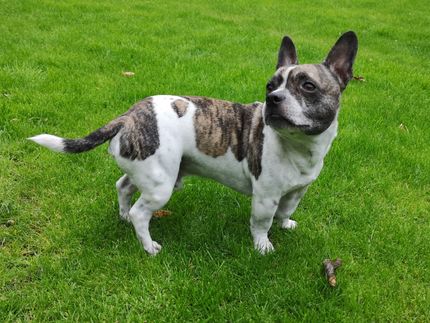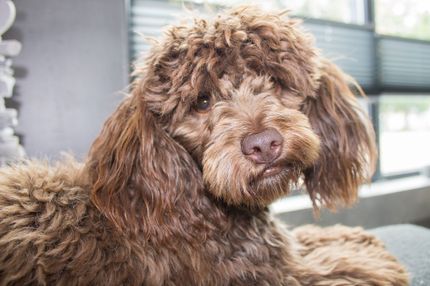Facts & Origin
The Cheeks - a Chihuahua and Pekingese mix
The Cheeks is a small hybrid breed created by crossing a Chihuahua with a Pekingese. The aim of this mix was to combine the charming characteristics of both breeds - the liveliness and alertness of the Chihuahua and the calm, dignified nature of the Pekingese - in a compact companion dog.
The breeding of this mix probably began in the USA, as with many so-called designer dogs. Unlike recognized breeds, there is no official breeding line or fixed standards for the Cheeks, which leads to a very variable appearance. Nevertheless, the Cheeks are enjoying growing popularity - especially among people who are looking for small, characterful dogs with a high cuddle factor.
Criticism of the Cheeks
As with many hybrid breeds, there is also criticism of the Cheeks, especially from animal welfare groups. A central problem is that designer dogs are often bred without serious breeding planning and without consideration for the health problems of the parent animals. The idea of "diluting" the typical breed-specific problems through crossbreeding only works if health-tested parents are bred together - which is not the case with many private breeders.
Both the Chihuahua and the Pekingese have genetic problems such as brachycephaly, misaligned teeth, eye problems and joint diseases, which do not necessarily improve in the mixed breed - sometimes they can even worsen.
In addition, some breeders run the risk of marketing dogs because of their appearance, regardless of temperament, health or husbandry recommendations. The Cheeks then becomes an "accessory" - with all the negative consequences for the animal.
Suitability of the Cheek
Despite justified criticism, a Cheek can be an affectionate and loyal companion if it comes from a responsible source and is kept appropriately. They are usually affectionate, people-oriented and generally well suited as an apartment dog. Many Cheeks show a mixture of the self-confident, watchful Chihuahua character and the calmer, sometimes stubborn nature of the Pekingese.
They need a close bond with humans, love to cuddle and are often very loyal - sometimes even a little possessive. Despite their size, they should not be underestimated: A Cheek needs clear rules, social contact and age-appropriate activity.
They are well suited to individuals, couples or families with older children who can meet the needs of a small dog with a strong character. The Cheeks is only suitable as a beginner's dog to a limited extent - but with the right knowledge, patience and time, it can be a wonderful companion.
| Alternate Name | Pekahuahua, Peki-Chi, Chi-Pek |
| Origin | Mexico - China |
| Life expectancy | 12 - 20 years |
| Care requirements | low-maintenance - high-maintenance |
| Activity level | low |
| FCI group | not recognised |
| AKC group | not recognised |
| KC group | not recognised |
More Chihuahua mixes
More Pekinese mixes
Attitude, character and temperament of the breed
Possible character traits
The Cheeks is generally a strong, alert and affectionate companion dog. It often combines the lively, courageous nature of the Chihuahua with the laid-back, sometimes stubborn personality of the Pekingese. The result is a dog that can be both lively and proud and independent.
Many Cheeks are very people-oriented and build up a close bond with their caregiver. They are often cuddly, loyal and alert at the same time - often with a certain tendency to be "bossy". Despite their small size, they are often self-confident, and in some cases also jealous or territorial, especially towards strangers or animals.
Their intelligence and independent mind make them dogs that need clear but loving training. Consistency is important, as a Cheek can certainly try to get his way - especially if he realizes that you will let him get away with anything.
Character
Usage
Possible diseases of the Cheek
As both the Chihuahua and the Pekingese are prone to certain breed-specific diseases, it is important to be aware of possible health risks in Cheeks. Mixed breeds are not automatically healthier - it depends heavily on genetics and the quality of breeding.
Typical health problems that can occur in Cheeks:
Brachycephaly (short-headedness): Especially when the Pekingese's flat facial skull becomes prominent, breathing problems, snoring and sensitivity to heat can occur.
Dental problems: Small breeds often have crowded teeth, which can lead to tartar, periodontitis and tooth loss.
Eye diseases: The large, protruding eyes can be prone to irritation, corneal injury or inflammation.
Joint problems, especially patellar luxation (a dislocation of the kneecap), are more common in small dogs.
Back problems: A long spine with short legs can lead to slipped discs.
Heart disease cannot be ruled out either, especially in old age.
Regular veterinary check-ups, dental care and a diet tailored to the breed size are crucial for a healthy life.
This is what a Cheeks can look like
The Cheeks is a small dog, usually weighing between 2.5 and 6 kilograms and with a shoulder height of around 15 to 25 centimetres. Its appearance varies depending on the genetic influence of the parent breeds, but in most cases it is a compact, well-proportioned small dog with a striking facial expression.
The head shape may resemble the round skull of the Chihuahua or the flat, broad head of the Pekingese. The muzzle is often shortened, but not to an extreme - it can, however, be somewhat longer. The eyes are large and expressive, often slightly protruding, which gives them a striking, "open" look.
The ears can be erect, semi-erect or drooping - depending on which genetic component is more dominant. The coat varies greatly: it can be short and smooth, semi-long or even slightly wavy. Some Cheeks have a dense undercoat, others a rather silky top coat.
They are also very diverse in terms of coloring - from cream, brown, black, white and tricolor to pied varieties, everything is possible.
Overall, the Cheeks look like a small, proud companion dog with a lot of charisma - charming, alert and with a mind of its own.
| Fur length | medium - long |
| Fur | flat coated |
| Ear shape | Standing Ears - Triangle |
| Tail | lang - fanned out |
| Anatomy | slim, strong |
| Size ♀ | 15 - 23 cm |
| Weight ♀ | 2 - 6 kg |
| Size ♂ | 15 - 23 cm |
| Weight ♂ | 2 - 6 kg |
| Suitable For | Children, Seniors, Beginner, Seniors |
Known Diseases
Eye diseases
Often occur with allergies and intolerances.
Hypoglycemia
If an insulin dose was overdosed or accidentally administered twice, the dog may experience hypoglycemia.
Tartar
If dogs don't get a good food or sugary food, tartar can quickly appear.
Eye infections
Chronic eye infections can be very painful in dogs and can be treated with medication. In rare cases, the cornea must be treated.
Denture malocclusions
Malocclusions of the dentition often occur in dogs with short muzzles.
Shortness of breath
Difficult breathing can be recognized by the dog's rattling and sometimes accelerated breathing rate.
Bronchitis
Bronchitis in dogs is an inflammation of the lower airways in the area of the bronchi.
Disc problems
Herniated disc in dogs (discopathy). Herniated discs or dachshund paralysis cause dogs severe pain.
FAQ
-
A cross between a Chihuahua and a Pekingese is also known as a Peki-Chi, Cheeks or Chi-Pek. These dogs are a mix of two popular toy breeds and are known for being small, affectionate and lively.
-
A Peki-Chi typically has the head and facial features of a Pekingese, but the small, compact body of a Chihuahua. These dogs usually have a long, dense coat that can be either straight or wavy, and they come in a variety of colors, including black, brown, white and cream.
-
Peki-Chis are small dogs that usually weigh between 1-3 kg and are 20-30 cm tall up to the shoulder.
-
Peki-Chis are generally friendly and outgoing dogs that enjoy being with people. They can be very playful and energetic, but also have a relaxed, gentle side. These dogs are usually good with children and other pets.
-
Yes, Peki-Chis are great family dogs. They are loving and affectionate dogs that enjoy spending time with their owners. They are also relatively easy to train and are not known for barking or chewing.





















